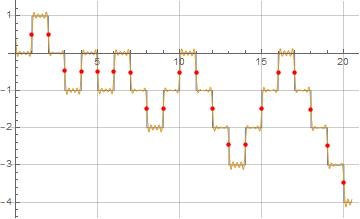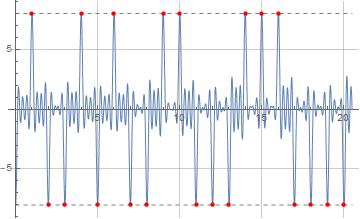$$\lambda(n)=(-1)^{\Omega(n)}=\sum\limits_{d^2|n}\mu\left(\frac{n}{d^2}\right)\tag{1}$$
$$L(x)=\sum\limits_{n\le x}\lambda(n)=\sum\limits_{n^2\le x} M\left(\frac{x}{n^2}\right)\tag{2}$$
where
$$M(x)=\sum _{n\le x}\mu(n)\tag{3}$$
The Mertens function $M(x)$ can also be evaluated as follows:
$$\quad M(x)=\sum\limits_{n=\left\lfloor\frac{x-2}{4}\right\rfloor+1}^{\left\lfloor\frac{x-1}{2}\right\rfloor}\mu(2\,n+1)\tag{4}$$
The summatory Liouville function $L(x)$ is related to the floor function $\lfloor x\rfloor$ as follows where $\nu(n)$ is the number of distinct primes dividing $n$:
$$L(x)=\sum\limits_{n\le x}2^{\,\nu(n)}\,\lambda(n)\left\lfloor\frac{x}{n}\right\rfloor\tag{5}$$
$$\lfloor x\rfloor=\sum _{n=1}^x 2^{\,\nu(n)}\,L\left(\frac{x}{n}\right)\tag{6}$$
Relationship (5) above leads to the following analytic representations of $L_o(x)=\underset{\epsilon\to 0}{\text{lim}}\frac{L(x-\epsilon)+L(x+\epsilon)}{2}$ and it's first-order derivative $L_o'(x)$ where the evaluation frequency $f$ is assumed to be a positive integer.
$$L_o(x)=\underset{N,f\to\infty}{\text{lim}}\left(\sum _{n=1}^N 2^{\,\nu(n)}\,\lambda(n) \left(\frac{x}{n}-\left(\frac{1}{2}-\frac{1}{\pi}\sum _{k=1}^{f\,n}\frac{\sin\left(\frac{2 \pi k x}{n}\right)}{k}\right)\right)\right),\quad x>0\tag{7}$$
$$L_o'(x)=\underset{N,f\to\infty}{\text{lim}}\left(\sum\limits_{n=1}^N\frac{2^{\,\nu(n)}\,\lambda(n)}{n}\left(1+2\sum\limits_{k=1}^{f\,n}\cos\left(\frac{2 \pi k x}{n}\right)\right)\right),\quad x>0\tag{8}$$
Figure (1) below illustrates $L_o(x)$ defined in formula (7) above in orange overlaid on the blue reference function $L(x)$ where formula (7) is evaluated at $N=111$ and $f=4$. I generally try to select $N$ such than $L_o(0)$ evaluates close to zero, and in the case of $N=111$, $L_o(0)$ evaluates to $\frac{1}{2}$. The red discrete portion of Figure (1) below illustrates the evaluation of $L_o(x)$ at positive integer values of $x$, and note this evaluation is consistent with the Heaviside step function half-step convention.
Figure (1): Illustration of formula (7) for $L_o(x)$ (orange) overlaid on $L(x)$ (blue)
I believe formula (8) for $L_o'(x)$ above converges (in a distributional sense) to $L'(x)=\sum\limits_n\lambda(n)\,\delta(x-n)$.
Now consider the following formula for $f_o'(x)$ which is a subset of formula (8) above for $L_o'(x)$.
$$f_o'(x)=\underset{N,f\to\infty}{\text{lim}}\left(2\sum\limits_{n=1}^N\frac{2^{\,\nu(n)}\,\lambda(n)}{n}\sum\limits_{k=1}^{f\,n}\cos\left(\frac{2 \pi k x}{n}\right)\right),\quad x>0\tag{9}$$
Figure (2) below illustrates $f_o'(x)$ defined in formula (9) above where formula (9) is evaluated at $N=111$ and $f=4$. The two dashed-gray horizontal gridlines are at $y=\pm 8$. The red discrete portion of Figure (2) below illustrates $f_o'(x)$ defined in formula (8) above evaluates to exactly $2\,f$ times the step size of $L(x)$ at positive integer values of $x\le N$.
Figure (2): Illustration of formula (9) for $f_o'(x)$


